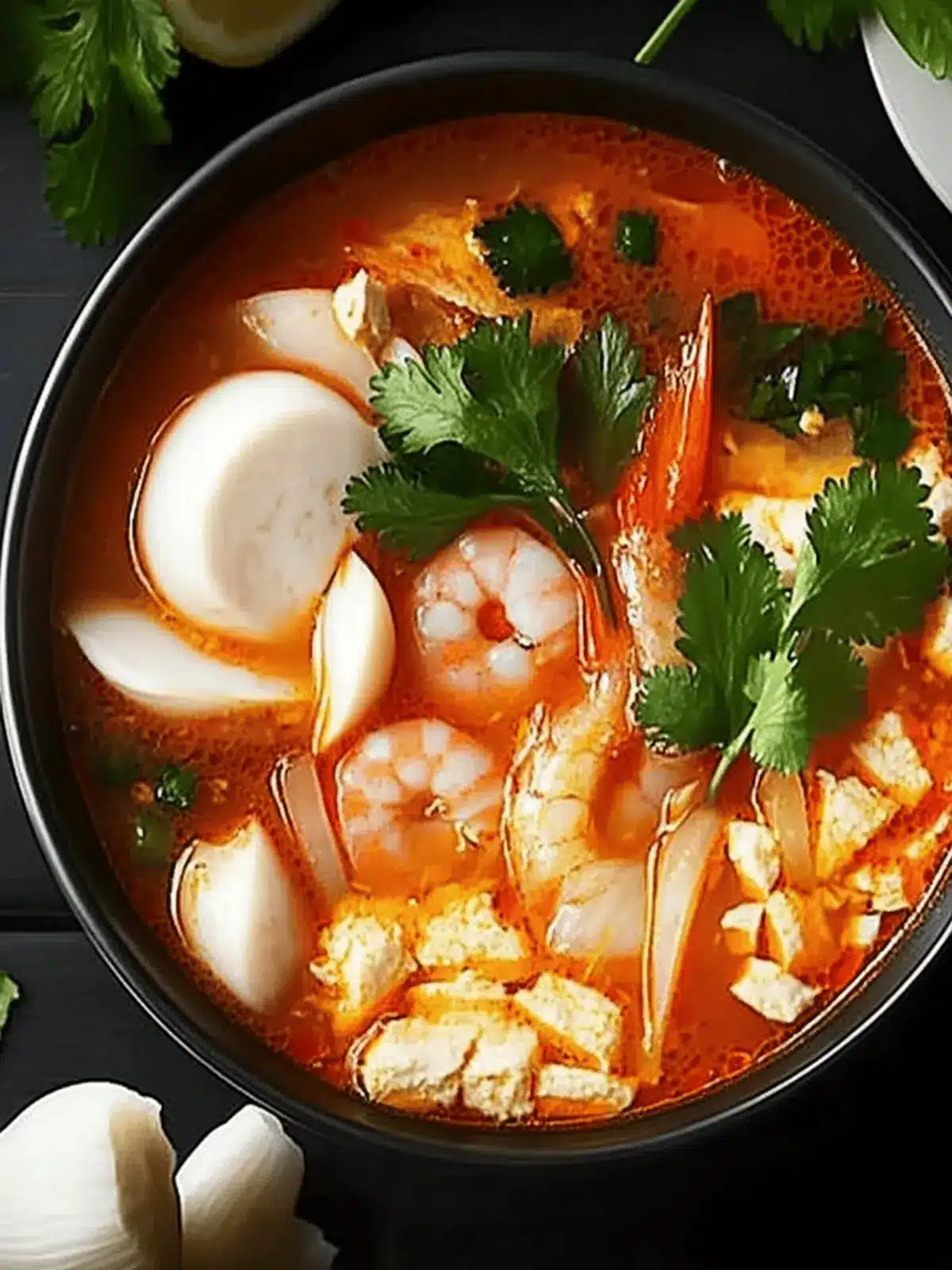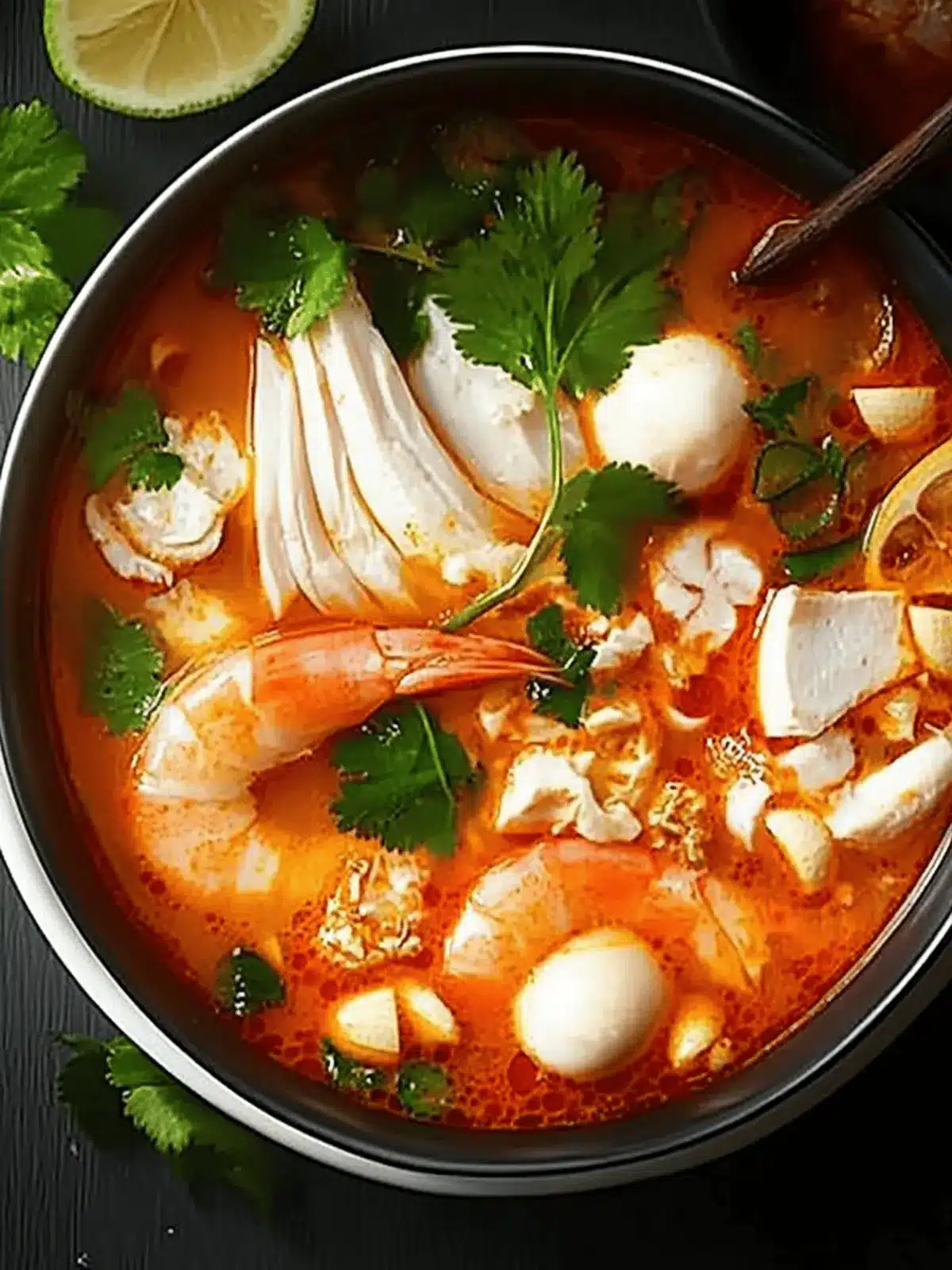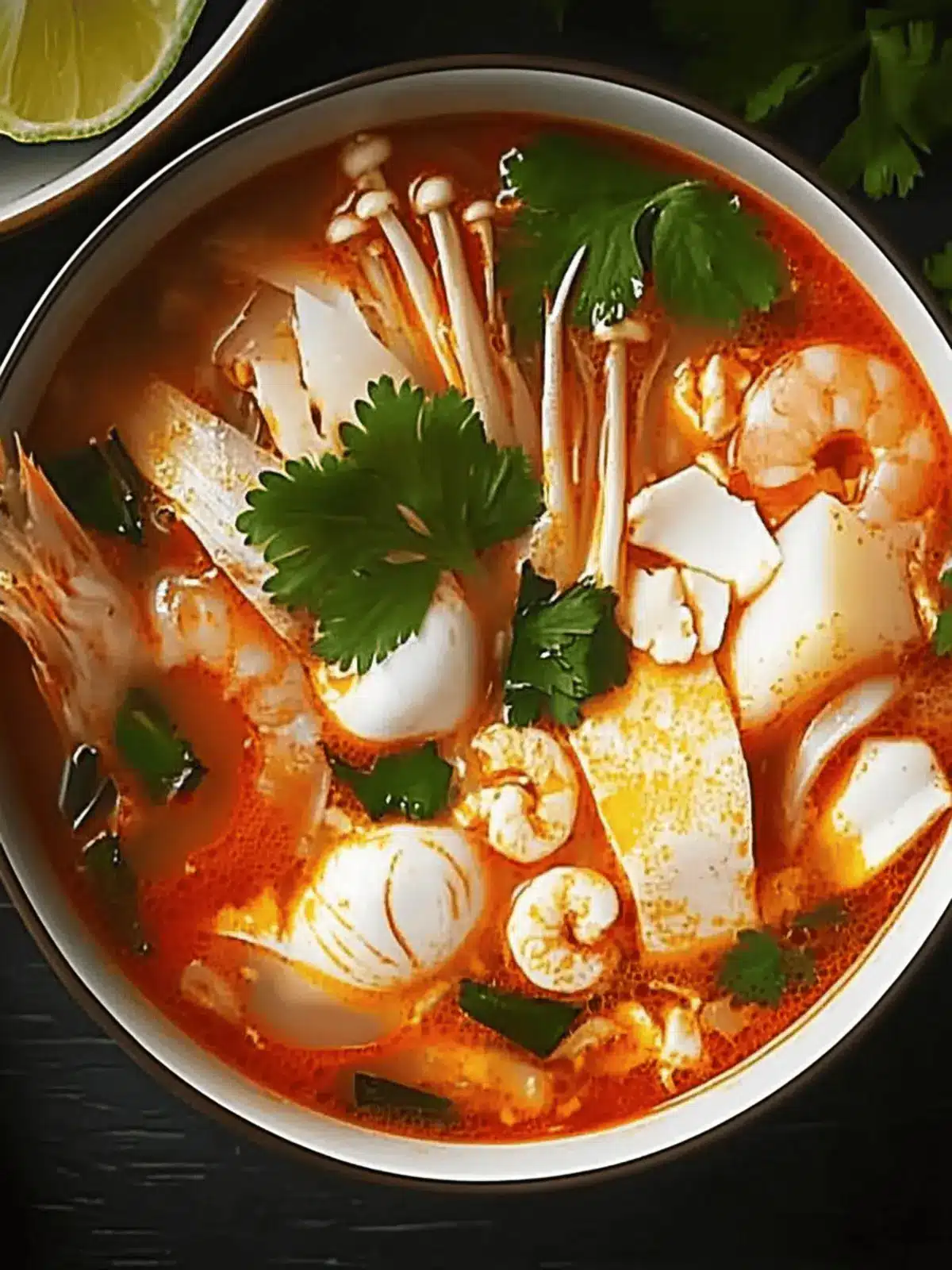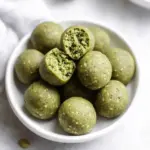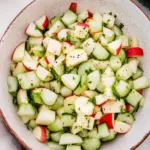The first taste of Tom Yum Soup takes me back to vibrant street markets in Thailand where the air is fragrant with with fresh herbs and spices. This soup is not only a culinary delight but also a nutritional powerhouse, boasting low calories while tantalizing your palate with its unique balance of spicy and sour flavors. It features aromatic staples like lemongrass, galangal, and zesty lime, all blended for a refreshing, heartwarming experience. Whether you’re looking for a quick weeknight dinner or a light lunch that fuels your day, this warming dish is adaptable too, easily transforming to accommodate shrimp, chicken, seafood, or even a vegetarian twist. With each slurp, you get an explosion of robust flavors and comforting sensations, reminding you why homemade food always feels like a warm hug on a chilly evening. Let’s dive into making your very own bowl of this iconic Thai masterpiece!
Why is Tom Yum Soup so special?
Flavor-packed and invigorating, this Tom Yum Soup delivers a burst of bold Thai essence in every spoonful. Quick and easy to prepare, it’s perfect for busy weeknights or a comforting lunch! Customizable to suit your taste, you can switch proteins or make it vegetarian without compromising flavor. Plus, it’s a nourishing choice, low in calories yet brimming with nutrients that boost your well-being. This soup is sure to impress family and friends, making it a go-to dish for gatherings or cozy nights in.
Tom Yum Soup Ingredients
- Dive into the essential components that make this delightful Tom Yum Soup truly irresistible!
For the Base
- Oil (vegetable or coconut) – Adds richness and helps to sauté aromatics. Substitute with sesame oil for an added flavor boost.
- Chicken stock – Forms the soothing broth. For a vegetarian version, replace with vegetable broth.
Aromatic Wonders
- Lemongrass – Provides a fresh citrusy flavor; smash before adding to release oils. Frozen lemongrass can be a great substitute if fresh is unavailable.
- Kaffir lime leaves – Impart a unique citrus aroma. Dried leaves can be used if fresh are not available, though the flavor will be less intense.
- Galangal (or ginger) – Adds a peppery aroma and taste; slice thinly. Ginger can replace galangal in a pinch, but the flavor will differ slightly.
- Thai chilies – Offer heat and depth; adjust quantity based on spice preference. Use red pepper flakes for a milder option.
- Onion – Adds sweetness and depth when sautéed. Optional: shallots can be used for a more delicate flavor.
Veggie Goodness
- Mushrooms – Provide texture; sliced or halved. Substitutes can include tofu for a vegetarian version.
- Tomato – Adds acidity and sweetness; cut into wedges. Cherry tomatoes can be used for a sweeter taste.
Flavor Enhancers
- Fish sauce – The primary source of umami; use soy sauce or tamari as a vegan alternative.
- Sugar – Balances the overall flavor; coconut sugar can be a natural alternative.
Main Proteins
- Shrimp – Provides protein and texture; adjust cooking time to prevent overcooking. Chicken or tofu can be swapped for a different protein.
Finishing Touches
- Lime juice – Snaps the soup with freshness; adjustable to taste. Lemon juice can be used in place of lime for a different citrus note.
- Fresh cilantro – For garnish; adds freshness. Basil can be used as another herb option.
How to Make Tom Yum Soup
- Heat oil in a large pot over medium heat; sauté sliced onions for about 2 minutes until they turn fragrant and translucent. This will form a lovely aromatic base for your soup.
- Pour in the chicken stock and bring it to a gentle simmer. The soothing broth will start to mingle with the sautéed onions, creating a delicious foundation.
- Add aromatics: Include lemongrass, kaffir lime leaves, galangal, and smashed Thai chilies; allow to simmer for 5-10 minutes to let the flavors infuse beautifully. Your kitchen will smell incredible!
- Stir in mushrooms and tomato; continue to simmer for an additional 5 minutes, allowing the vegetables to soften while enriching the broth with their flavors.
- Mix in fish sauce and sugar, then add shrimp; cook for 2-3 minutes until the shrimp turn pink and are just cooked through, ensuring they remain tender and juicy.
- Remove from heat; stir in the fresh lime juice to brighten the soup. Taste and adjust the lime according to your preference for tanginess.
- Serve rustic style by straining the soup if desired, or ladling it directly into bowls. Garnish generously with fresh cilantro and serve hot for that comforting experience!
Optional: Pair with jasmine rice or a fresh spring roll for a complete meal.
Exact quantities are listed in the recipe card below.
Tom Yum Soup Variations
Feel free to let your creativity shine and adapt this beloved recipe to your taste preferences!
- Shrimp Swap: Replace shrimp with chicken or tofu for a delightful twist depending on your protein preference.
- Creamy Addition: For a rich texture, stir in coconut milk or evaporated milk alongside the other ingredients.
- Veggie Boost: Add extra vegetables like bok choy or spinach to increase the soup’s nutrition and color.
- Mushroom Medley: Experiment with different types of mushrooms, such as shiitake or enoki, to enhance depth and flavor.
- Heat Adjustment: Use chili paste for a more intense heat, or dried red pepper flakes for a milder spice level in your soup.
- Citrus Variation: Amp up the flavor by adding a splash of orange juice or zest for a sweet citrus note.
- Herb Infusion: Instead of cilantro, try fresh basil or mint for a refreshing herb twist that complements the soup beautifully.
- Noodle Addition: Serve over rice noodles or thin vermicelli to transform it into a hearty meal in a bowl.
Expert Tips for Tom Yum Soup
- Smash for Flavor: Always smash your aromatics like lemongrass and galangal to maximize flavor extraction in your Tom Yum Soup.
- Cook Shrimp Last: Add the shrimp towards the end of cooking to prevent overcooking and ensure tender, flavorful bites.
- Taste as You Go: Don’t hesitate to taste your broth regularly; adjust the seasonings to balance the spicy and sour flavors effectively.
- Use Fresh Ingredients: Opt for fresh herbs and vegetables whenever possible, as they greatly enhance the soup’s overall taste, especially the aromatics.
- Customize Wisely: Feel free to switch proteins or add vegetables, but be cautious with cooking times to maintain the essence of your Tom Yum Soup.
What to Serve with Tom Yum Soup?
Elevate your dining experience by pairing comforting favorites alongside this aromatic Thai delight.
-
Jasmine Rice: This fluffy staple provides a neutral base that soaks up the vibrant broth, making each bite even more satisfying.
-
Fresh Spring Rolls: Crisp vegetables wrapped in tender rice paper deliver a delightful crunch, balancing the soup’s flavors and adding a refreshing element.
-
Coconut Rice: Sweet and creamy, it complements the spicy notes of the soup, creating a lovely contrast that feels like a tropical escape.
-
Thai Noodles: These soft, chewy noodles stir in beautifully with the broth, lugging their own flavor while enhancing the overall texture of the meal.
-
Grilled Shrimp Skewers: Add a protein boost with these smoky, juicy bites that echo the shrimp in the soup, while providing an additional layer of taste.
-
Chilled Cucumber Salad: A refreshing side that cools the palate, this salad brings a light and crunchy texture that perfectly offsets the soup’s warmth.
-
Mango Sticky Rice: For a sweet finish, this luscious dessert melds perfectly with the soup’s flavors and rounds out your meal with a satisfying sweetness.
-
Lemonade or Thai Iced Tea: Sip on these refreshing beverages that marry well with Tom Yum Soup, cleansing your palate between bites while enhancing your overall dining experience.
Make Ahead Options
Preparing Tom Yum Soup in advance is a brilliant way to save time during busy weeknights! You can chop the vegetables and aromatics, such as lemongrass and galangal, up to 24 hours ahead, storing them in an airtight container in the refrigerator to maintain freshness. Additionally, you can make the broth and refrigerate it for up to 3 days, ensuring you reheat gently on the stove before serving. To finish the soup, simply re-add the chopped veggies and shrimp when you’re ready to eat. This way, you’ll enjoy an incredibly flavorful bowl of soup that feels just as fresh and vibrant without the stress of last-minute cooking!
How to Store and Freeze Tom Yum Soup
- Fridge: Store leftover Tom Yum Soup in an airtight container for up to 3 days. Reheat gently on the stovetop, adding a splash of broth to restore its yummy consistency.
- Freezer: For longer storage, freeze Tom Yum Soup in a freezer-safe container for up to 3 months. Thaw overnight in the fridge before reheating for the best flavor.
- Room Temperature: Avoid leaving Tom Yum Soup at room temperature for more than 2 hours to prevent bacterial growth and maintain its delicious taste.
- Reheating: When reheating, use medium heat to warm the soup through, ensuring shrimp are not overcooked. Adjust seasoning, adding fresh lime juice if needed for brightness.
Tom Yum Soup Recipe FAQs
What type of lemongrass should I use for Tom Yum Soup?
Absolutely! Fresh lemongrass is the best choice as it provides an unparalleled citrus flavor. When selecting, choose stalks that are firm with a pale base and a green top. Smash the stalks before adding them to release their fragrant oils. If fresh lemongrass isn’t available, you can opt for frozen lemongrass as a suitable substitute, although it may lack some of the freshness.
How should I store leftover Tom Yum Soup?
After cooking, let the soup cool down before transferring it to an airtight container. It can be stored in the refrigerator for up to 3 days. When reheating, do so gently on the stovetop, adding a bit of broth to restore the soup’s original consistency. I often find that a splash of fresh lime juice added during reheating can brighten the flavors beautifully!
Can I freeze Tom Yum Soup for later use?
Yes, you can definitely freeze Tom Yum Soup! To do this, pour the cooled soup into a freezer-safe container, leaving some space at the top for expansion. It will keep well for up to 3 months in the freezer. When you’re ready to enjoy it, thaw overnight in the fridge and reheat gently on the stove. Just keep an eye on the shrimp; you’ll want to avoid overcooking them again!
What should I do if my soup is too spicy?
If your Tom Yum Soup turns out spicier than you’d anticipated, don’t worry! One effective way to balance the heat is to add a bit of coconut milk or an extra splash of broth. This will help mellow the spice while enhancing the creamy texture. You can also add more tomatoes or mushrooms, as their sweetness can counterbalance the heat!
Is Tom Yum Soup safe for pets?
While some ingredients in Tom Yum Soup are healthy for humans, such as vegetables, be cautious sharing it with pets. Garlic and onions, common in this soup, are toxic to dogs and cats. If you want to make a pet-friendly boiler, consider preparing a separate broth with safe ingredients like chicken or vegetables without any harmful spices. Always consult your veterinarian for specifics on your pet’s dietary needs!
Can I substitute shrimp with another protein?
Very! If you prefer chicken, that’s a fantastic option. Simply cut the chicken into bite-sized pieces and add them to the soup earlier in the cooking process than shrimp—approximately 5-7 minutes before the soup is done. For a vegetarian version, tofu is a perfect substitute! Just make sure to add it with the mushrooms so it can soak up all those lovely flavors.
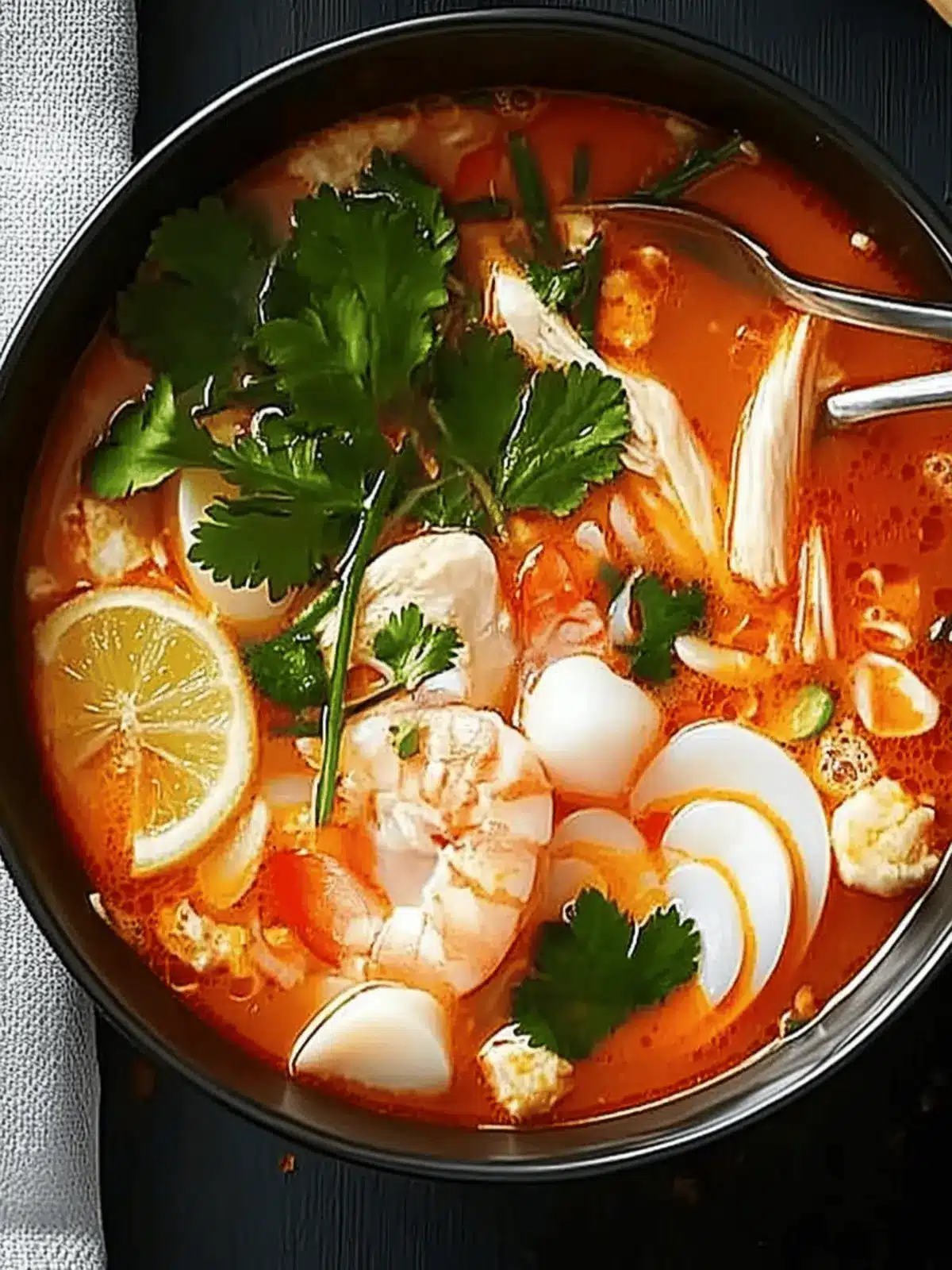
Savory Tom Yum Soup – Your Ultimate Healthy Comfort Bowl
Ingredients
Equipment
Method
- Heat oil in a large pot over medium heat; sauté sliced onions for about 2 minutes until fragrant and translucent.
- Pour in the chicken stock and bring it to a gentle simmer.
- Add lemongrass, kaffir lime leaves, galangal, and smashed Thai chilies; allow to simmer for 5-10 minutes.
- Stir in mushrooms and tomato; continue to simmer for an additional 5 minutes.
- Mix in fish sauce and sugar, then add shrimp; cook for 2-3 minutes until shrimp turn pink.
- Remove from heat; stir in fresh lime juice to brighten the soup.
- Serve by ladling into bowls, garnished with fresh cilantro.

